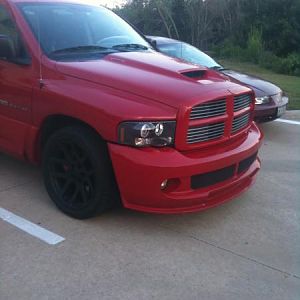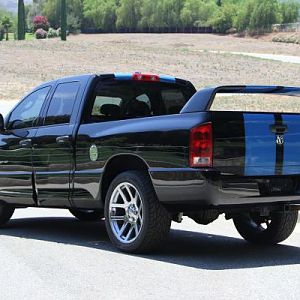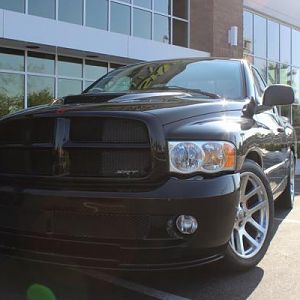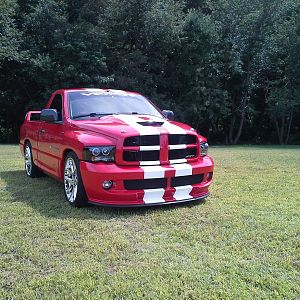Someone please add me to the list......you guys had to know I would be interested! And you know I am serious.
You are using an out of date browser. It may not display this or other websites correctly.
You should upgrade or use an alternative browser.
You should upgrade or use an alternative browser.
Long Bar update!
- Thread starter ARRESTmeRed04
- Start date
rare03srt10
Full Access Member
Someone please add me to the list......you guys had to know I would be interested! And you know I am serious.
Well id be down to buy someones Cal-Tracs off them then hahaha
1. Arrestmered04
2. Lethal Hemi
3. Yellowfever#154
4. Ramsrt711
5. Mysrt10
6. Trainman
2. Lethal Hemi
3. Yellowfever#154
4. Ramsrt711
5. Mysrt10
6. Trainman
mopar_mudder
Full Access Member
No I don't want any but so food for thought, actually I should build and sell these my self and make my millions...:dontknow:
On my off-road truck I run a 4 link set-up back and front with leaf springs and NO spring bind at all (well very limited, my geometry is not perfect, this is a redneck back yard creation). The secret? Well is is really simple and I can't believe it is not more common, I guess though if you are going 4 link you are pretty serious and doing coil overs any way. But if you want to do it with leaf springs you just need to replace the front spring mount with another shackle. Yes I run shackles on both ends of all four springs. This lets the springs expland both forward and backward as the axle moves up and compresses the springs.
On my off-road truck I run a 4 link set-up back and front with leaf springs and NO spring bind at all (well very limited, my geometry is not perfect, this is a redneck back yard creation). The secret? Well is is really simple and I can't believe it is not more common, I guess though if you are going 4 link you are pretty serious and doing coil overs any way. But if you want to do it with leaf springs you just need to replace the front spring mount with another shackle. Yes I run shackles on both ends of all four springs. This lets the springs expland both forward and backward as the axle moves up and compresses the springs.
chrisheltra
Full Access Member
just askin a question here.....
would a pinion snubber & cal-tracs get the same thing done as the long bars or would the weight transfer not be the same???:dontknow::dontknow:
This is what my initial answer is but after some more thought it may change slightly:
No, slappers and caltracs exert pressure in an upward motion on the frame which causes the natural tendency for the rear to want to unload and lift under heavy acceleration.
Long bars exert lateral pressure to the frame mount which doesnt cause the rear lift issue.
VENOMOUS1 RACING
Has Left the Room - Banned from VTCOA!
just askin a question here.....
would a pinion snubber & cal-tracs get the same thing done as the long bars or would the weight transfer not be the same???:dontknow::dontknow:
They would not be as effective as a long bar type setup for sure. Caltracs are great for sure, but we need something that is longer, therefore picking up the front of the truck on launches and out of turns, to in turn plant the rear tires in the pavement to gain traction which in turn creates quicker 60fts.
As Chris said, it all matters where the instant center of gravity is. There are mathmatical formulas used to find that instant center. First is to get a front and rear weight of the truck, then find where the lift/attachment point would be based on that. The main point is to use the motion of the rear end under launch to transfer to the bars, which in turn will transfer into the middle of the frame, therefore lifting the front of the truck! Like also stated, years back Ladder Bars were the **** and they went to the middle front of the car/truck. Trans Ams and Camaros have used a single long bar for years to aid in traction and it does very well, especially the aftermarket ones used to replace the factory one.
All goes back to physics. When you mash the gas, your springs take the wrap of the movement of the rear axle since it is attached to them. We have all seen warped spring packs because of this fact. The long bars or caltracs use that momentum created by the rear axle rotation and transfer that to the frame, therefore lifting the front and taking the shock off the leaf springs.
It's all to be thought of as simple as this.............. Tighten a head bolt with a short 3/4 ratchet and fight for 135ft/lbs torque, or use a torque wrench with a long handle to easily tighten to the same 135ft/lbs.
Use a screwdriver to pry open a house door, or use a prybar? The leverage factor is the physics behind the whole traction bar science:burnout:
Sorry so long but maybe it will help in understanding the principals.
This is what my initial answer is but after some more thought it may change slightly:
No, slappers and caltracs exert pressure in an upward motion on the frame which causes the natural tendency for the rear to want to unload and lift under heavy acceleration.
Long bars exert lateral pressure to the frame mount which doesnt cause the rear lift issue.
are we talkin the same thing here????
slappers to me are what goes on the spring. a pinion snubber goes on the top of the axle housin & either contacts the floor pan or bracket to limit axle movement.
goggle pinion snubber for a photo. can't do it at work
chrisheltra
Full Access Member
are we talkin the same thing here????
slappers to me are what goes on the spring. a pinion snubber goes on the top of the axle housin & either contacts the floor pan or bracket to limit axle movement.
goggle pinion snubber for a photo. can't do it at work
Your talking bump stops..... Not sure what they have in common with long bars or caltrac. Im gonna have to go back and read the previous posts. Im confused now.
They would not be as effective as a long bar type setup for sure. Caltracs are great for sure, but we need something that is longer, therefore picking up the front of the truck on launches and out of turns, to in turn plant the rear tires in the pavement to gain traction which in turn creates quicker 60fts.
As Chris said, it all matters where the instant center of gravity is. There are mathmatical formulas used to find that instant center. First is to get a front and rear weight of the truck, then find where the lift/attachment point would be based on that. The main point is to use the motion of the rear end under launch to transfer to the bars, which in turn will transfer into the middle of the frame, therefore lifting the front of the truck! Like also stated, years back Ladder Bars were the **** and they went to the middle front of the car/truck. Trans Ams and Camaros have used a single long bar for years to aid in traction and it does very well, especially the aftermarket ones used to replace the factory one.
All goes back to physics. When you mash the gas, your springs take the wrap of the movement of the rear axle since it is attached to them. We have all seen warped spring packs because of this fact. The long bars or caltracs use that momentum created by the rear axle rotation and transfer that to the frame, therefore lifting the front and taking the shock off the leaf springs.
It's all to be thought of as simple as this.............. Tighten a head bolt with a short 3/4 ratchet and fight for 135ft/lbs torque, or use a torque wrench with a long handle to easily tighten to the same 135ft/lbs.
Use a screwdriver to pry open a house door, or use a prybar? The leverage factor is the physics behind the whole traction bar science:burnout:
Sorry so long but maybe it will help in understanding the principals.
good read. i remember the ladder bar craze, lol. rode in a couple of cars that had them, they would bite for sure.
are we talkin the same thing here????
slappers to me are what goes on the spring. a pinion snubber goes on the top of the axle housin & either contacts the floor pan or bracket to limit axle movement.
goggle pinion snubber for a photo. can't do it at work
Pinion snubber and caltracs go the same thing, just a different way of doing it. The long bars control axle wrap too but also transfer the force of that rotation to a point on the frame farther up which causes the front end to lift, transfering weight to the rear axle for more traction
Your talking bump stops..... Not sure what they have in common with long bars or caltrac. Im gonna have to go back and read the previous posts. Im confused now.
its just an "old school" way of limitin pinion movement
VENOMOUS1 RACING
Has Left the Room - Banned from VTCOA!
its just an "old school" way of limitin pinion movement
It is the same material as a bumpstop ( Urethane) but is called a PINION SNUBBER as Carl stated. Bumpstops are just that, to stop the axle from hitting the frame. Pinion Snubber does basically the same but the pinion would contact a fabbed mount or floorboard (weak spot) to prevent axle rotation.
It is the same material as a bumpstop ( Urethane) but is called a PINION SNUBBER as Carl stated. Bumpstops are just that, to stop the axle from hitting the frame. Pinion Snubber does basically the same but the pinion would contact a fabbed mount or floorboard (weak spot) to prevent axle rotation.
Is that what this does?
Attachments
mopar_mudder
Full Access Member
Is that what this does?
That would be an old school slapper bar
This is a pinion snubber

That would be an old school slapper bar
This is a pinion snubber

Thanks man.:rock:
rare03srt10
Full Access Member
They would not be as effective as a long bar type setup for sure. Caltracs are great for sure, but we need something that is longer, therefore picking up the front of the truck on launches and out of turns, to in turn plant the rear tires in the pavement to gain traction which in turn creates quicker 60fts.
As Chris said, it all matters where the instant center of gravity is. There are mathmatical formulas used to find that instant center. First is to get a front and rear weight of the truck, then find where the lift/attachment point would be based on that. The main point is to use the motion of the rear end under launch to transfer to the bars, which in turn will transfer into the middle of the frame, therefore lifting the front of the truck! Like also stated, years back Ladder Bars were the **** and they went to the middle front of the car/truck. Trans Ams and Camaros have used a single long bar for years to aid in traction and it does very well, especially the aftermarket ones used to replace the factory one.
All goes back to physics. When you mash the gas, your springs take the wrap of the movement of the rear axle since it is attached to them. We have all seen warped spring packs because of this fact. The long bars or caltracs use that momentum created by the rear axle rotation and transfer that to the frame, therefore lifting the front and taking the shock off the leaf springs.
It's all to be thought of as simple as this.............. Tighten a head bolt with a short 3/4 ratchet and fight for 135ft/lbs torque, or use a torque wrench with a long handle to easily tighten to the same 135ft/lbs.
Use a screwdriver to pry open a house door, or use a prybar? The leverage factor is the physics behind the whole traction bar science:burnout:
Sorry so long but maybe it will help in understanding the principals.
Wow thank you for that information bro! :rock:
This would be a scary ride on a roadway! With all 4 wheels reacting differently with every bump!! It would be all over the damn road at any time!!! Keep it in the ditches !!! Lol.No I don't want any but so food for thought, actually I should build and sell these my self and make my millions...:dontknow:
On my off-road truck I run a 4 link set-up back and front with leaf springs and NO spring bind at all (well very limited, my geometry is not perfect, this is a redneck back yard creation). The secret? Well is is really simple and I can't believe it is not more common, I guess though if you are going 4 link you are pretty serious and doing coil overs any way. But if you want to do it with leaf springs you just need to replace the front spring mount with another shackle. Yes I run shackles on both ends of all four springs. This lets the springs expland both forward and backward as the axle moves up and compresses the springs.
They would not be as effective as a long bar type setup for sure. Caltracs are great for sure, but we need something that is longer, therefore picking up the front of the truck on launches and out of turns, to in turn plant the rear tires in the pavement to gain traction which in turn creates quicker 60fts.
As Chris said, it all matters where the instant center of gravity is. There are mathmatical formulas used to find that instant center. First is to get a front and rear weight of the truck, then find where the lift/attachment point would be based on that. The main point is to use the motion of the rear end under launch to transfer to the bars, which in turn will transfer into the middle of the frame, therefore lifting the front of the truck! Like also stated, years back Ladder Bars were the **** and they went to the middle front of the car/truck. Trans Ams and Camaros have used a single long bar for years to aid in traction and it does very well, especially the aftermarket ones used to replace the factory one.
All goes back to physics. When you mash the gas, your springs take the wrap of the movement of the rear axle since it is attached to them. We have all seen warped spring packs because of this fact. The long bars or caltracs use that momentum created by the rear axle rotation and transfer that to the frame, therefore lifting the front and taking the shock off the leaf springs.
It's all to be thought of as simple as this.............. Tighten a head bolt with a short 3/4 ratchet and fight for 135ft/lbs torque, or use a torque wrench with a long handle to easily tighten to the same 135ft/lbs.
Use a screwdriver to pry open a house door, or use a prybar? The leverage factor is the physics behind the whole traction bar science:burnout:
Sorry so long but maybe it will help in understanding the principals.
Although your leverage logic is sound, it is backwards. The lift of the ladderbar would be lost in the length. The power applied is from the axle not the end of the longbar. The strength of the longbar is it's length to stabilize the diff from turning at all. Preload would be more difficult
mopar_mudder
Full Access Member
This would be a scary ride on a roadway! With all 4 wheels reacting differently with every bump!! It would be all over the damn road at any time!!! Keep it in the ditches !!! Lol.
Why would it. 4 Link hold the axle perfect all the time. The springs are exactly the same, you are just alowing them to move forward as well as back.
I run my off-roader and the road all the time. After doing this mod the road manners got way better, no more wishy washy flat tire feel. Got to rember 10+ inches of lift and 40" tires.
It was just food for though for thoose worried about binding.
Support Us
Become A Supporting Member Today!






